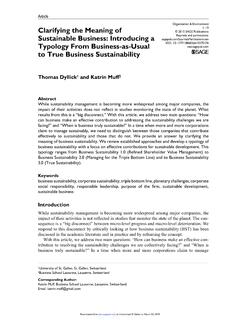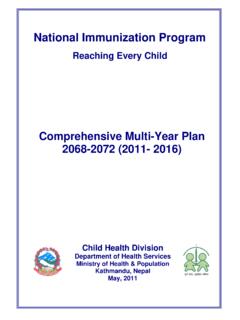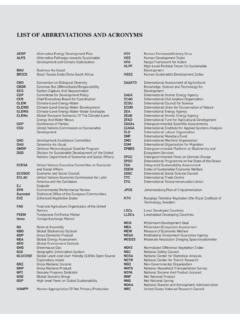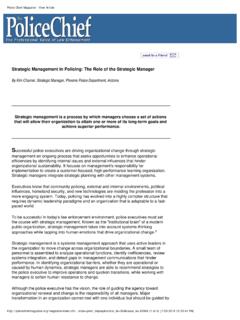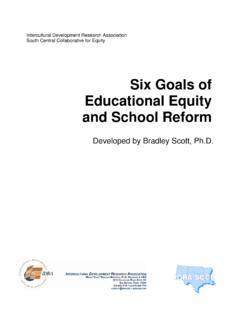Transcription of Successful Sustainability Strategy: Procter & Gamble Case
1 Successful Sustainability Strategy: Procter & Gamble Case Franco Luc Completion Date: May 17th 2016 Case approved by: Dr. Bettina Palazzo 1 EXECUTIVE SUMMARY This case study examines Procter & Gamble s (P&G s) journey towards true Sustainability . P&G is recognised and verified as a strong Sustainability player and has received several certifications by independent organisations in the field of corporate Sustainability . Furthermore, the company is working towards its long-term 2020 vision and pursuing significant initiatives in addressing social and environmental issues while successfully fulfilling its economic goals.
2 Based on these parameters, P&G was chosen during the research process as a partner for this case study. This case study will reflect how an organisation makes progress and adapts during the challenging path towards sustainable development. The case study explores the historical timeline of P&G to evaluate the progress made in the adoption of business Sustainability . The second section will analyse the results from the Sustainability culture and leadership assessment (SCALA) survey, which will provide the reader with the employees perspectives regarding the company s Sustainability culture.
3 The third section will synergize the data provided in the first two sections and will compare the company to the Dyllick and Muff typology of Sustainability (Dyllick & Muff, 2015). The story of P&G s Sustainability strategy is about change. This case study provides evidence that to implement its strategy and achieve the level of true Sustainability , P&G has to develop a sense of urgency throughout the whole company. The main challenge in achieving true Sustainability is the change process. Successful Sustainability change initiatives have to be driven internally. Sustainability IN THE CONTEXT OF CHANGE For the past 60 years, P&G has committed to creating an environment that includes social and environmental goals in their business conduct.
4 Despite these consistent efforts for Sustainability at P&G, in 2013 and 2014, the media repeatedly reported that P&G and many other companies were sourcing palm oil from suppliers connected to widespread forest devastation (Greenpeace, 2014b), done to create land for palm oil plantations. Articles with headlines like P&G s Dirty Secret reported that P&G s sourcing policies expose its supply chain to forest fires and habitat destruction (Maitar, 2014). In 2013, Greenpeace began investigating P&G s supply chain for more than a year and found that an orangutan habitat was being cleared in a plantation linked to P&G s supply chain.
5 Land used for palm oil cultivation owned by the BW Plantation Group, a company connected to P&G s supply chain, was also linked with the deaths and burials of orangutans next to the Tanjung Putting National Park. In other cases, Greenpeace documented ongoing forest clearance within the concessions of two producers known to be directly supplying P&G. In June 2013, more than 150 fire hotspots were recorded within these concessions. A few months later, articles, such as P&G Commits to Protect World s Rainforests , began to appear in the media (Gies, 2014). On 26 March 2014, five Greenpeace volunteers presented P&G with a worst-of award (the Golden Axe), which claimed 2 that P&G was buying palm oil from companies that destroy Indonesia s rainforests.
6 Greenpeace presented the award at Europe s biggest cosmetic and detergent convention, Cleaning Products Europe, in Manchester, England. The Sustainability director for P&G was addressing the industry audience, and Richard George, forests campaigner for Greenpeace UK, joined her at the podium and presented her with the award. He said, There were many companies in the running for this award, but P&G s brazen claim that buying palm oil from companies that destroy the rainforest was sustainable made it the stand-out winner. That level of chutzpah needs rewarding, so we re pleased to award Procter & Gamble with the Golden Axe award for services to deforestation.
7 The conference attendees were also provided with a brochure, which argued that, despite their protestations of Sustainability and family-friendliness, P&G fuels deforestation by buying palm oil from some of the most destructive companies in Indonesia (Greenpeace, 2014c). This case reflects the widespread effect of highly visible companies, such as P&G, promoting their active participation in the Sustainability movement and the difficulty of evaluating the validity of such claims. The sourcing of palm oil is a complex topic because it has both negative and positive side effects, with a positive being that its economic value rescued many Indonesians from poverty.
8 Furthermore, Greenpeace failed to underline that, in 2013, P&G and many other companies were actively working towards 100% Roundtable on Sustainable Palm Oil (RSPO) certification as a way to demonstrate responsible sourcing. Greenpeace focused on their belief that RSPO certification was insufficient and pushed for specific changes to RSPO and supplier sourcing policies. Still, P&G did make changes to their sourcing policies that aligned with the requests of Greenpeace and other non-governmental organisations (NGOs); as a consequence, by the end of March 2014, The Guardian stated that Greenpeace believed that P&G was taking steps to clean up its palm oil sourcing practices (Hamid, 2014).
9 In April 2014, P&G said it had eliminated deforestation from all of its palm oil sourcing practices and announced a non-deforestation policy for all of its products (Greenpeace, 2014a; Greenpeace, 2014b; Baker, 2014). In this perspective, P&G confirmed the goal of establishing traceability to palm oil mills by working closely with suppliers to ensure no deforestation in their supply chain by 2020 in its Sustainability Report 2015. This goal also applies to palm kernel oil suppliers with the aim of improving both practices and livelihoods to establish zero deforestation in the P&G supply chain by 2020.
10 Currently, the company is under track to achieve these goals. P&G s issues surrounding palm oil indicate that P&G has proven its ability to react and change its Sustainability strategy in urgent situations. Does it suggest that nothing will change without a sense of urgency including Sustainability policy or strategy? Were Greenpeace s claims true? In addition, does the palm oil accusation prove that P&G has not had sustainable practices in the past? The palm oil issue faced by P&G has proven to the outside world that the company has made a big step forward in making Sustainability strategies a respected and integrated topic.
